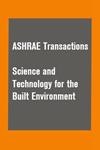Development and experimental performance characteristics of composite coated daytime radiative water cooler
IF 1.6
4区 工程技术
Q3 CONSTRUCTION & BUILDING TECHNOLOGY
Science and Technology for the Built Environment
Pub Date : 2023-07-03
DOI:10.1080/23744731.2023.2234249
引用次数: 1
Abstract
The daytime radiative cooling technology may be effectively used to passively cool the water and hence mitigate the undesirable solar water heating of the roof-top storage tank in the summer. Hence, this work presents the radiative water cooler design, development and experimental and numerical performance characteristics. Radiative water cooler surface coating has been developed using the polymer (PMMA)-particle (barium sulfate) composite structure. The effects of various water inlet temperatures and volume flow rates on the water temperature drop and cooling capacity are experimentally and numerically performed. Sub-ambient water cooling throughout the day is observed for a range of 0.1–0.4 L/min water flow rates at the near-ambient inlet temperature conditions. The maximum sub-ambient water temperature drop of 6.1 °C (that of 3.5 °C at noon) is observed with a developed radiative cooler for the flow rate of 0.1 l/min. The usage of the daytime radiative water cooler for sub-ambient water temperature drop is found to be more suitable for above-ambient water inlet temperature. Apart from the solar irradiance, ambient temperature, ambient humidity, wind velocity and coating surface emissivity characteristics, cooling capacity and surface temperature distribution of radiative water cooler also depend on the water inlet conditions.复合涂层日间辐射水冷器的研制及实验性能特点
白天的辐射冷却技术可以有效地对水进行被动冷却,从而减轻夏季屋顶储水箱的太阳能加热问题。因此,本文介绍了辐射式水冷器的设计、研制及实验和数值性能特点。采用聚合物(PMMA)-颗粒(硫酸钡)复合结构,研制了辐射水冷器表面涂层。实验和数值模拟了不同进水温度和容积流量对冷却水降温和制冷量的影响。在接近环境的入口温度条件下,在0.1-0.4升/分钟的水流量范围内,观察到全天的亚环境水冷却。在流速为0.1 l/min的情况下,开发的辐射冷却器观测到亚环境水温最大下降6.1℃(中午为3.5℃)。使用日间辐射式冷水机进行亚环境水温下降更适合高于环境的进水温度。除了太阳辐照度、环境温度、环境湿度、风速和涂层表面发射率特性外,辐射式冷水机的制冷量和表面温度分布还取决于进水条件。
本文章由计算机程序翻译,如有差异,请以英文原文为准。
求助全文
约1分钟内获得全文
求助全文
来源期刊

Science and Technology for the Built Environment
THERMODYNAMICSCONSTRUCTION & BUILDING TECH-CONSTRUCTION & BUILDING TECHNOLOGY
CiteScore
4.30
自引率
5.30%
发文量
78
期刊介绍:
Science and Technology for the Built Environment (formerly HVAC&R Research) is ASHRAE’s archival research publication, offering comprehensive reporting of original research in science and technology related to the stationary and mobile built environment, including indoor environmental quality, thermodynamic and energy system dynamics, materials properties, refrigerants, renewable and traditional energy systems and related processes and concepts, integrated built environmental system design approaches and tools, simulation approaches and algorithms, building enclosure assemblies, and systems for minimizing and regulating space heating and cooling modes. The journal features review articles that critically assess existing literature and point out future research directions.
 求助内容:
求助内容: 应助结果提醒方式:
应助结果提醒方式:


